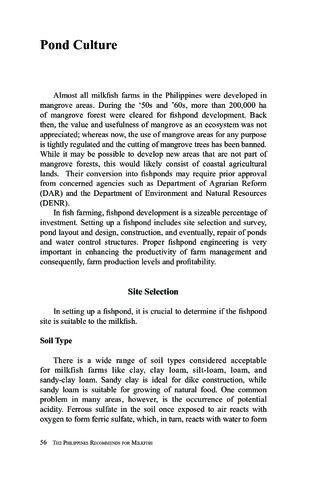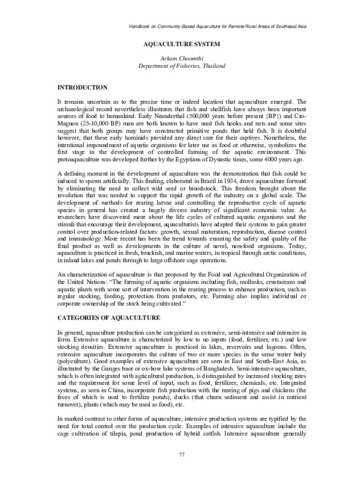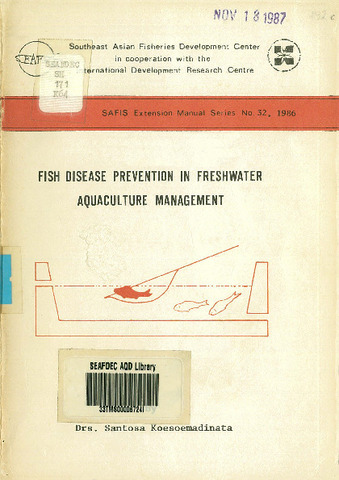Lime application to condition soil to pH 11 controls growth of harmful vibrios and WSSV
Share
| dc.contributor.author | Tendencia, Eleonor | |
| dc.contributor.author | Coniza, Eliseo B. | |
| dc.date.accessioned | 2023-06-07T02:16:39Z | |
| dc.date.available | 2023-06-07T02:16:39Z | |
| dc.date.issued | 2023-05-26 | |
| dc.identifier.citation | Tendencia, E. A., & Coniza, E. B. (2023). Lime application to condition soil to pH 11 controls growth of harmful vibrios and WSSV. Bulletin of the European Association of Fish Pathologists, 43(2). https://doi.org/10.48045/001c.74917 | en |
| dc.identifier.issn | 0108-0288 | |
| dc.identifier.uri | http://hdl.handle.net/10862/6445 | |
| dc.description.abstract | Shrimp farming has been devastated by several diseases. Disease outbreaks can be prevented by optimising environmental conditions or by eliminating risks factors including carrier organisms. These can be achieved through proper pond preparation. One important step in pond preparation is the application of hydrated lime. This paper describes the effect of hydrated lime application to condition pond soil to pH 11 on the pond ecosystem, more specifically on soil pH and biota. The experiment was done using three 600 m2 brackish water ponds. After hydrated lime application, the wet soil pH on the 1st-8th day was significantly higher (P<0.05) compared to the pH before liming to pH 11, and flushing after flooding for 24 h. Soil pH of 11 was observed 24-48h after lime application. Moreover, unwanted species like crabs and fish were found dead. Liming to pH 11 negatively affects the counts of green vibrio colonies thereby decreasing the percentage of green vibrios (PGV). In another experiment, three 750m2 earthen ponds were used. The pond soils were previously positive for the Whitespot Syndrome Virus (WSSV), hydrated lime were applied to bring the pond soil pH to 11. After lime application, WSSV was not detected in the pond soils. Results showed that increasing the soil pH to ≥11 positively affects the pond ecosystem. Liming encourages the proliferation of yellow vibrios and the eradication of carrier species (i.e. crabs) as well as predators (i.e. fish) in the ponds. Furthermore, liming to pH 11 may also eradicate White spot virus from the pond sediment. To implement a 1-unit increase in wet pH, hydrated lime should be applied at 2T/ha. | en |
| dc.description.sponsorship | The study was funded by the Government of Japan (GoJ), under the trust fund awarded to SEAFDEC/AQD (study code: 8300-T-RD-FH0710). | en |
| dc.language.iso | en | en |
| dc.publisher | European Association of Fish Pathologists | en |
| dc.relation.uri | https://eafpbulletin.scholasticahq.com/article/74917.pdf | en |
| dc.rights | Attribution 4.0 International | |
| dc.rights.uri | http://creativecommons.org/licenses/by/4.0 | |
| dc.subject | Penaeus vannamei | en |
| dc.subject | limes | en |
| dc.subject | soil pH | en |
| dc.title | Lime application to condition soil to pH 11 controls growth of harmful vibrios and WSSV | en |
| dc.type | Article | en |
| dc.citation.volume | 43 | en |
| dc.citation.issue | 2 | en |
| dc.citation.journalTitle | Bulletin of the European Association of Fish Pathologists | en |
| dc.subject.asfa | shrimp culture | en |
| dc.subject.asfa | White spot syndrome virus | en |
| dc.subject.asfa | vibriosis | en |
| dc.subject.asfa | bacterial diseases | en |
| dc.identifier.doi | 10.48045/001c.74917 | |
| dc.subject.scientificName | Litopenaeus vannamei | en |
| dc.subject.scientificName | Penaeus vannamei | en |
| local.subject | Hydrated lime | en |
| local.subject | soil pH | en |
| local.subject | Vibrios | en |
| local.subject | WSSV | en |
Files in this item
| Files | Size | Format | View |
|---|
This item appears in the following Collection(s)
-
AQD Journal Articles [1218]
These papers were contributed by AQD staff to various national and international journals




